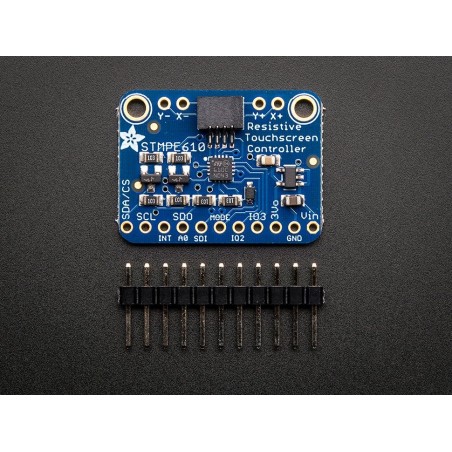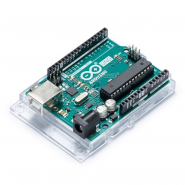- DISCONTINUED






Connect a resistive touch screen from an LCD and transmit information to a microcontroller using I2C or SPI interfaces. An interrupt pin indicates the microcontroller that a touch has been detected.
Getting touchy performance with your screen's touch screen? Resistive touch screens are incredibly popular as overlays to TFT and LCD displays. Only problem is they require a bunch of analog pins and you have to keep polling them since the overlays themselves are basically just big potentiometers. If your microcontroller doesn't have analog inputs, or maybe you want just a way more elegant controller, the STMPE610 is a nice way to solve that problem.
This breakout board features the STMPE610, which has both I2C and SPI interfaces available. There is also an interrupt pin that you can use to indicate when a touch has been detected to your microcontroller or microcomputer. We wrapped up the chip with a 3V voltage regulator and level shifting so it's safe to use with 3V or 5V logic. Its a nicely designed chip, and has very stable precise readings. We found its also a lot faster than trying to do all the readings on an Arduino.
For the screens that have 1mm pitch FPC cables, you can plug the cable right into the connector. The majority of medium/large touchscreens have that kind of connector. If you have another kind of touch screen, the four X/Y contacts are available on 0.1" pitch breakouts so you can hand-solder or wire them.
Getting started is super easy with our well-written STMPE610 Arduino library which supports I2C, hardware SPI, and software SPI. Plug any 1mm-pitch 4-wire resistive touchscreen to the on-board FPC connector. When you touch the screen, you'll get readings on the serial console. The wiring information is contained in the example sketch.
Resistive Touch Screen Controller - STMPE610 (18:26)
Related products

Connect a resistive touch screen from an LCD and transmit information to a microcontroller using I2C or SPI interfaces. An interrupt pin indicates the microcontroller that a touch has been detected.

